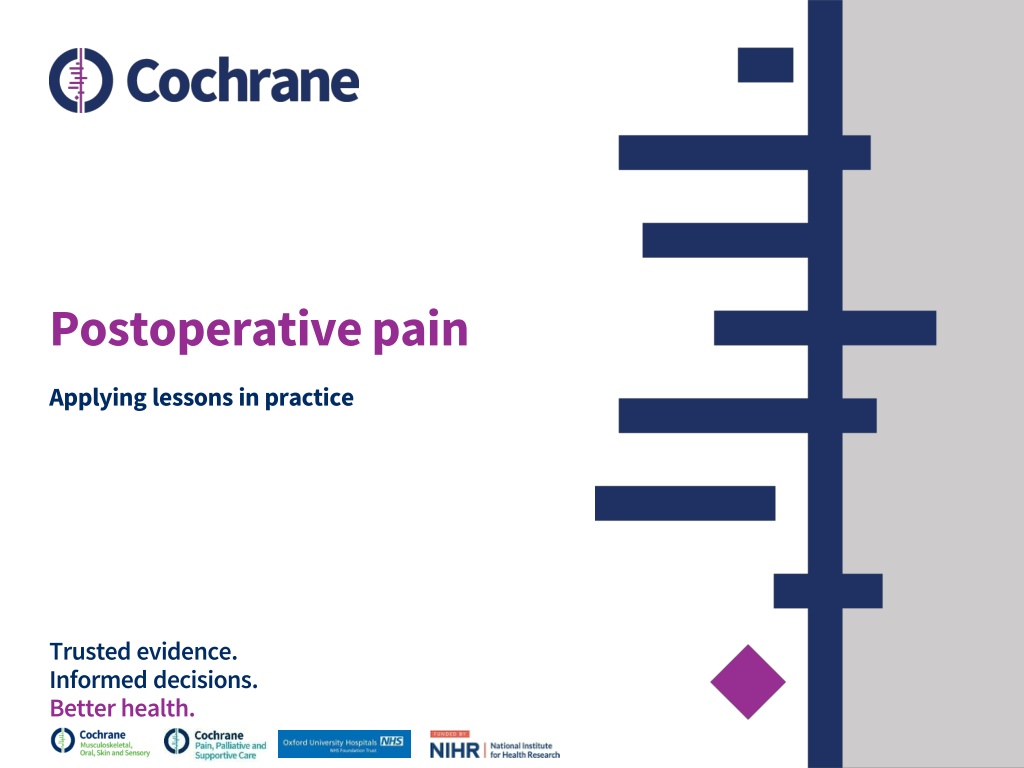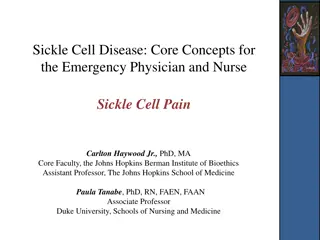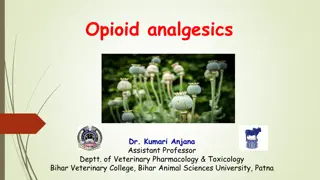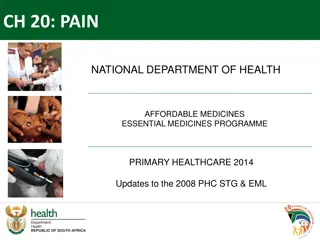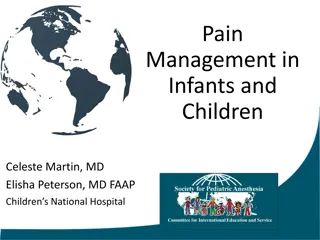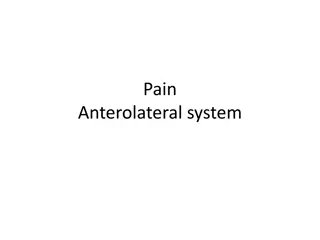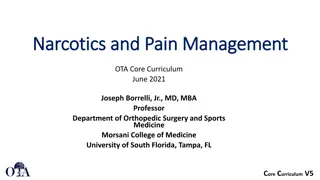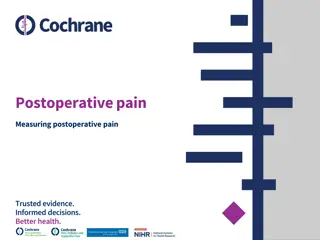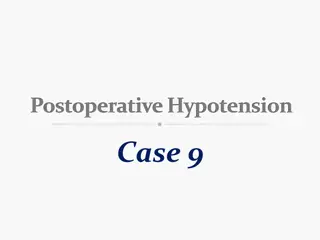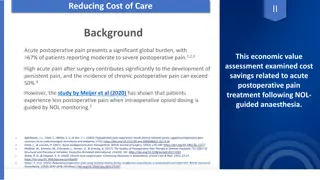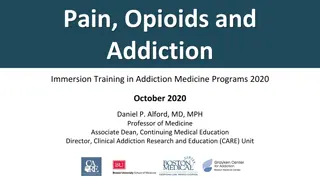Understanding Postoperative Pain Management: Lessons in Practice
Exploring the impact of perioperative intravenous ketamine on acute postoperative pain in adults, a review analyzed data from 130 studies with 8341 participants. The study focused on pain intensity, opioid consumption, and surgery type, presenting results using graphical approaches. Key findings highlighted ketamine's pain reduction effects and its implications for improved pain management strategies post-surgery.
Download Presentation

Please find below an Image/Link to download the presentation.
The content on the website is provided AS IS for your information and personal use only. It may not be sold, licensed, or shared on other websites without obtaining consent from the author. Download presentation by click this link. If you encounter any issues during the download, it is possible that the publisher has removed the file from their server.
E N D
Presentation Transcript
Postoperative pain Applying lessons in practice Trusted evidence. Informed decisions. Better health.
Contents 01 Looking at data in practice, and methods 02 Pain at rest effect of size 03 Pain at rest effect of pain level with control 04 Opioid consumption effect of size 05 Opioid consumption effect of consumption with control 06 Conclusions
Looking at data in practice Example review is Perioperative intravenous ketamine for acute postoperative pain in adults , CD012033 Published December 2018 few additional studies in the intervening period Complex review requiring considerable protocol development Included 130 studies with 8341 participants, not all of whom provided data for all analyses Largest data sets were for pain and opioid consumption over the first 24 postoperative hours
Methods The review had prespecified sensitivity analysis criteria of: study size (larger than median, and over 50/group) pain intensity in placebo control (> 40/100 mm visual analogue scale (VAS)) type of surgery Here we repeat some of these analyses but using graphical approaches to be able to view the data itself rather than the results of statistical analyses This can provide a different way of understanding some of the issues in previous slide sets (see https://papas.cochrane.org/resources/acute-pain-outcomes)
Methods The following slides show graphics and analyses performed using the data from the original review Done using Excel for calculations and Numbers for graphics Any pooled data were calculated using weighting by study size, which is not available in RevMan, but is more convenient for exploratory analyses Looks at pain at rest at 24 hours and cumulative opioid consumption by 24 hours as these provided the largest data sets in the review Examined first by size, and then by pain or opioid consumption in placebo controls
Pain at rest -24 hours postoperatively This analysis depended on 82 RCTs with 5000 participants Most ketamine or placebo trials arms involved small numbers of participants The review concluded that ketamine reduced pain by about 5 mm (3.6 to 6.6 mm on a 0 -100 mm VAS) with high quality evidence
Pain at rest effect of size Graphic shows the mean difference (mm VAS) between treatment and placebo plotted against the total number of participants in the comparison Size of symbol proportional to number of participants Conclusion: there is only a small effect of size (number of participants) on pain at rest overall, but a few smaller trials appear to be outliers
Pain at rest effect of size Conclusion of no major effect of study size on result emphasized by pooled analysis conducted in various size bands Small effect in smaller studies declines somewhat with larger size But clinical significance of results across all sizes of study is debatable MEAN DIFFERENCE PI KETAMINE-PLACEBO MM/100 -5.3 -6.5 -5.0 -1.6 -2.7 PARTICIPANTS IN COMPARISON NUMBER OF TRIALS NUMBER OF PATIENTS 20-40 41-60 61-80 81-100 101-154 Note that calculations performed on different basis to RevMan, using weighting by size 22 33 14 6 7 789 1785 1009 529 926
Pain at rest effect of pain in placebo Graphic shows the mean difference (mm VAS) between treatment and placebo plotted against pain intensity with placebo Size of symbol proportional to number of participants Conclude that there appears to be a trend with bigger effects where there was more pain with control
Pain at rest effect of pain in placebo Suggests that effectiveness of ketamine may be greater where there is more pain in the placebo group Larger effect where pain with control was moderate or severe ( 40/100 mm), and little effect where there was little or no pain Makes the result one of real clinical importance where pain is greater PAIN LEVEL WITH PLACEBO MM/100 O-20 21-30 31-40 >40 Note that calculations performed on different basis to RevMan, using weighting by size MEAN DIFFERENCE PI KETAMINE-PLACEBO MM/100 -1 -4 -6 -14 NUMBER OF TRIALS NUMBER OF PATIENTS 1883 1351 875 860 28 33 16 14
24-hour opioid consumption This analysis depended on 65 RCTs with 4000 participants Most ketamine or placebo trials arms involved small numbers of participants The review concluded that ketamine reduced opioid consumption by about 8 mg morphine equivalent (6 to 9) with moderate quality evidence
Opioid consumption effect of size Graphic shows the mean difference (mg morphine equivalent) between treatment and placebo plotted against the total number of participants in the comparison Size of symbol proportional to number of participants Conclude that there is only a small effect of size on opioid consumption overall, but a few smaller trials appear to be outliers
Opioid consumption effect of size Suggests no consistent effect of study size on result emphasized by pooled analysis conducted in various size bands Analysis by study size show no consistent trends Clinical significance of results is highly variable between groups MEAN DIFFERENCE KETAMINE-PLACEBO MG MORPHINE -5.1 -10.7 -6.2 +1.9 -17.6 PARTICIPANTS IN COMPARISON NUMBER OF TRIALS NUMBER OF PATIENTS 20-40 41-60 61-80 81-100 101-154 Note that calculations performed on different basis to RevMan, using weighting by size 17 30 8 4 7 552 1598 587 360 907
24-hour opioid consumption in placebo Large degree of variability in terms of opioid consumption with placebo From almost no consumption to > 100 mg morphine equivalent in 24 hours Impossible to measure effect with low consumption Is there a threshold?
Opioid consumption in placebo Graphic shows the mean difference (mg morphine equivalent) between treatment and placebo plotted against opioid consumption with placebo Size of symbol proportional to number of participants Conclude that there appears to be a trend with bigger effects where there was more opioid consumption with control
Opioid consumption in placebo Conclusion of major effect of opioid consumption in control groups emphasized by a sensitivity analysis Larger effect where pain with control was above 40 mg/24 hours, and little effect where it was below 40 mg/24 hours Makes the result one of real clinical importance where higher opioid consumption is expected (prior use of opioids for chronic pain) 24 HR OPIOID CONSUMPTION WITH PLACEBO (MG MORPHINE) 0-20 20-40 40-60 60-100 >100 Note that calculations performed on different basis to RevMan, using weighting by size NUMBER OF TRIALS NUMBER OF PARTICIPANTS MEAN REDUCTION (MG MORPHINE) 18 21 16 8 3 1155 1209 987 345 308 -4 -2 -12 -22 -42
Conclusions More detailed sensitivity analyses demonstrate that there can be large and clinically significant effects on pain-related outcomes depending on features of design or results of included studies In this case these were related to event rates in control for pain and analgesic consumption Other examples have shown study size to be important The take-home message is to be aware that, for pain outcomes, there are important criteria of inclusion and/or analysis that are not found in the Cochrane Handbook
Acknowledgements Thank you to the Cochrane Network Innovation Fund Thank you to Mohammed A. Abusayed (University Hospitals of Derby and Burton, UK) for auditing reviews of interventions for pain in the Cochrane Library in 2016 Thank you to all the project team members and MOSS key contacts Joanne Abbott; Geert Crombez; Rob Dellavalle; Christopher Eccleston; Anna Erskine; Emma Fisher; Kerry Harding; Jennifer Hilgart; John Lawrenson; Hopin Lee; Nuala Livingstone; Lara Maxwell; Andrew Moore; Gill Norman; Neil O'Connell; Roses Parker; Phil Riley; Kate Seers; Teo Aminah Wasteneys Quay; Andrew Smith; Martin Tram r; Peter Tugwell; Katie Webster; Amanda C de C Williams All the slides and documents hosted on the PaPaS website https://papas.cochrane.org/resources/acute-pain-outcomes
